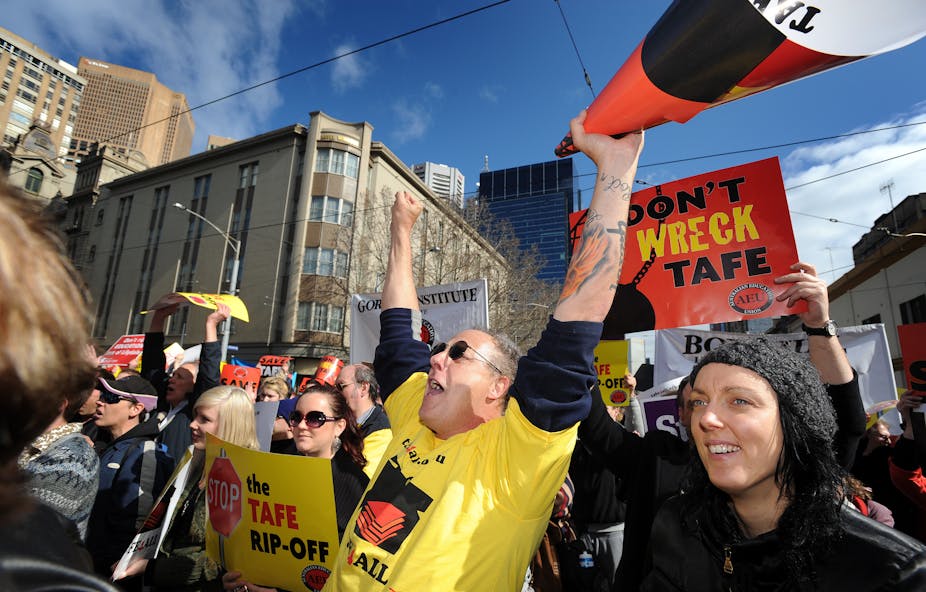TAFE staff are striking today to demonstrate their opposition to unparalleled funding cutbacks totalling almost $300 million imposed by the Victorian State Government.
A recent leaked cabinet paper summarising so called “TAFE transition plans” has incited outrage. The plans show that campuses will close, TAFE institutes will merge, at least two thousand staff will be sacked, students will pay higher fees and TAFE institutes will cut provision or close down courses.
The Commonwealth government is now threatening to withhold hundreds of millions of dollars earmarked for vocational education and training.
However, the Victorian government is not alone. The New South Wales government is cutting $80 million and 800 teaching jobs from TAFE, while increasing student fees by 9.5%. A Queensland government review of vocational education and training recommends closing 38 TAFE campuses and the Queensland government has cut $78.8 million from training, tertiary education and employment.
These state governments have failed to appreciate how important TAFE is to our economy and the community more generally. To them the vital work TAFE does is invisible.
But while TAFE’s effect might not be visible to politicians, it is an essential economic, social and cultural support for Australian communities and regions. Without strong TAFEs, there could be serious changes to our social cohesion and economic future.
The benefits of TAFE
TAFEs are often one of the biggest employers in regional or outer metropolitan areas and a focus for the community.
All TAFE directors in Australia will be on their local regional economic development committee and work together with local government and industry leaders to identify economic problems and skill requirements.
All TAFEs have staff working with schools to support better outcomes for students, and they work with local communities to develop programs and support for disadvantaged students. They provide pathways to higher education and to the professions, and in doing so, support Australia’s need for highly educated workforce and social mobility. They run courses that meet local economic or social needs even when it isn’t good business sense to do so.
Perhaps the least visible aspect of the work of TAFEs is how they anticipate the knowledge and skills that will be needed to support innovation. Just as universities create new knowledge for society and train the professions, TAFE’s role as an educational and training institution is to anticipate how workplaces are changing, and the kind of knowledge and skills that will be needed for tomorrow and not just today.
Every Australian has benefited from the contribution TAFE has made to economic development and social inclusion. Cutting TAFE is akin to a farmer eating rather than planting their seeds. We are cutting now rather than investing in the future.
Can universities take over?
Universities and TAFE play complementary roles, but whereas the role that universities play is well understood, TAFE’s role is not. Without TAFE, new knowledge that is generated in universities will not be translated into new work practices.
Universities can never take over the space vacated by TAFE, even if they wanted to. Universities might offer more “middle level” programs, such as diplomas and associate degrees, but they can’t offer the range of programs that TAFE offers at all skill levels. They also don’t have the same links with workplaces that TAFEs have, nor do they have the same geographic reach of TAFE.
There are hundreds of TAFE campuses in Australia in cities and regional and rural areas, which is the very reason many universities want to partner with TAFE institutes. Closing TAFE campuses in regions will reduce access to vocational and higher education.
Political will
The problem is that state governments don’t understand the invisible role TAFE plays. Instead, they are mesmerised by the invisible hand of the market and think it will all turn out in the end: it won’t and we will all be the poorer for it.
TAFE is far more than a “provider” of courses that is interchangeable with private providers. It is an educational institution that contributes to economic, social and cultural development, which private for profit providers can never replicate.
This piece was co-authored by Brendan Sheehan, a Melbourne policy consultant and former Skills Victoria executive. He publishes The Scan which reports on developments in tertiary education in Australia.

